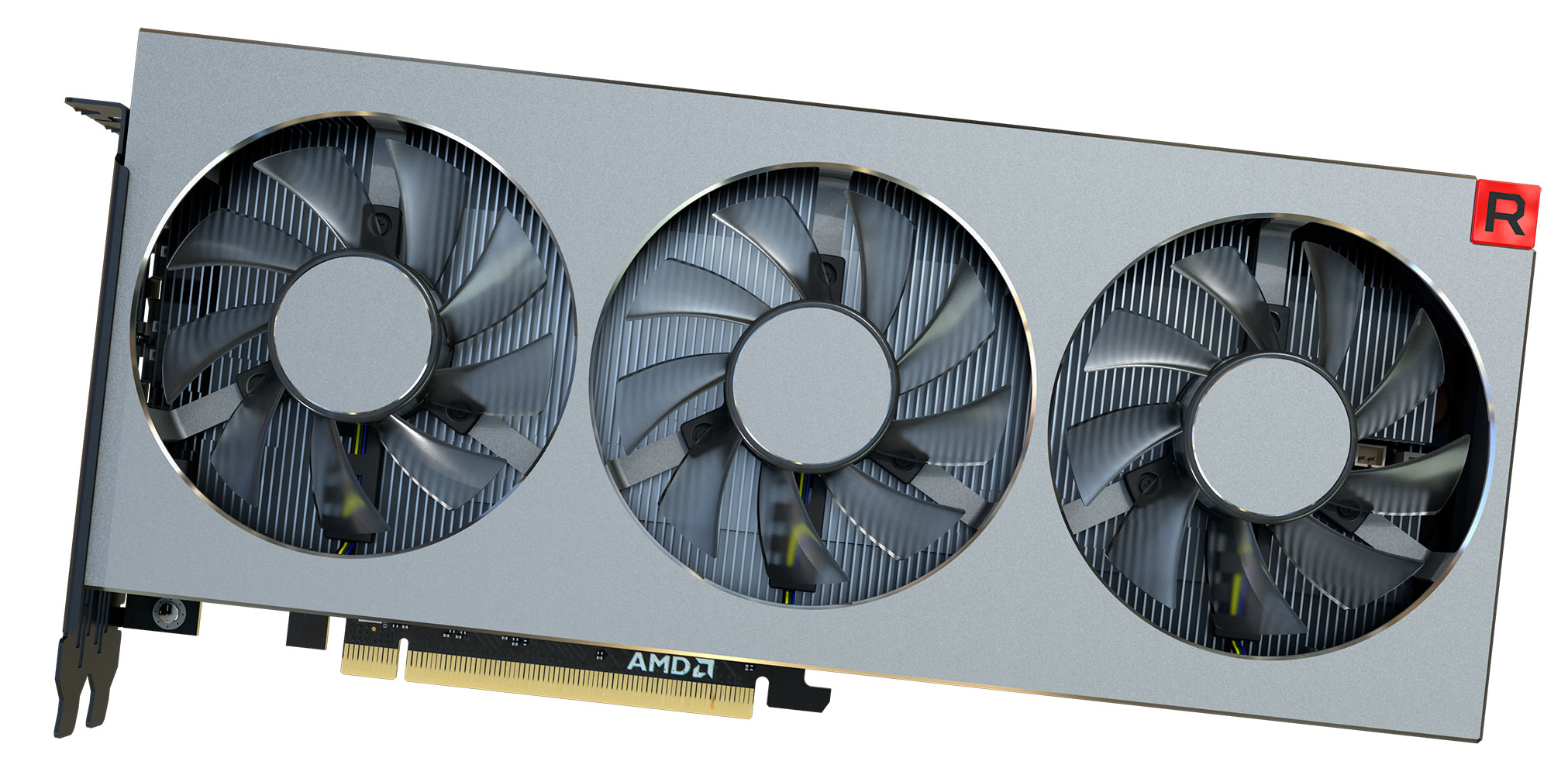AMD Shares More Details On The Radeon VII
Yesterday was an exciting day for AMD aficionados as the California chipmaker announced its Radeon VII and demoed its third-generation Ryzen processors. AMD aims to target gaming enthusiasts and content creators with its new gaming graphics card.
Many enthusiasts were praying for a Navi announcement. However, they received a die-shrunk version of Vega 10 instead. The Radeon VII employs AMD's existing Vega 20 graphics processor. In case you haven't been following AMD's discrete graphics card evolution, Vega 20 made its debut with the chipmaker's Radeon Instinct MI60 and MI50 data center graphics cards a couple of months ago. Both Vega 10 and Vega 20 take after the Graphics Core Next (GCN) 5.0 microarchitecture.
Meet The AMD Radeon VII
Vega 10 was manufactured by GlobalFoundries under the company's 14nm FinFET node. It measured 487mm² and contained up to 12,500 million transistors. For Vega 20, AMD turned to TSMC and its 7nm FinFET manufacturing process. Although Vega 20 only measured 331mm², the die housed up to 13,230 million transistors. Thanks to this die-shrunk, AMD was able to deliver up to 1.8 times the gaming performance per area and double the memory capacity and memory bandwidth on the Radeon VII in comparison to the Radeon RX Vega 64.
The AMD Radeon VII comes equipped with 60 compute units, and since the graphics card adheres to the GCN standard, this tallies up to 3,840 stream processors, 240 TMUs (texture mapping units), and 64 ROPs (render output units). AMD states that the Radeon VII will feature a 1,450MHz base clock and a boost clock that escalates up to 1,800MHz. The Radeon VII is good for up to 13.8 TFLOPs of single-precision floating-point performance.
On the memory side, it sports 16GB of HBM2 (second-generation High-Bandwidth Memory) operating across a 4,096-bit memory bus, which is capable of delivering a phenomenal memory bandwidth of up to 1 TB/s. AMD didn't disclose the Radeon VII's memory speed. However, if we do the math, the memory would need to be clocked at 1,000MHz (2,000MHz effective) to achieve a throughput of 1024 GB/s.
The Radeon VII's reference design flaunts a silver shroud, three cooling fans, and an illuminated Radeon logo on the side. On top of that, the graphics card is outfitted with two 8-pin PCIe power connectors. Although AMD didn't reveal the TDP (thermal design power), the Radeon VII's triple-fan cooler suggests it's somewhere in the range of around 295W. The reference model exhibited at AMD's CES 2019 keynote comes with three DisplayPort outputs and a single HDMI port.
Radeon VII vs Radeon RX Vega 64 vs GeForce RTX 2080
In order to prove the Radeon VII's prowess, AMD pitched the graphics card against the Radeon RX Vega 64 and the Nvidia GeForce RTX 2080 with the first being the flagship that it's replacing, and the latter being the rival it's targeting. AMD's results looked promising and revealed that the red chipmaker is closing the performance gap with Nvidia.
Get Tom's Hardware's best news and in-depth reviews, straight to your inbox.
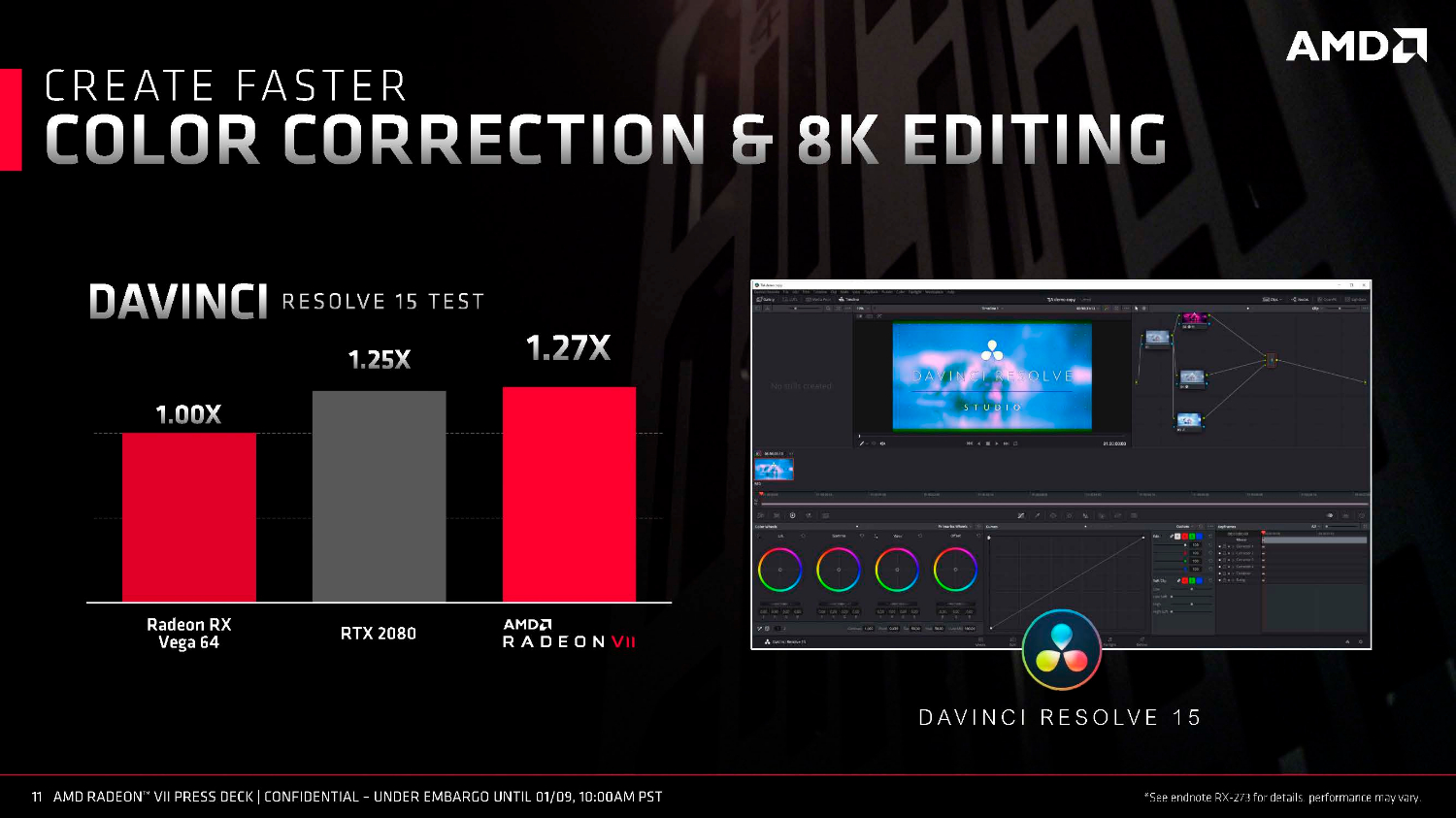
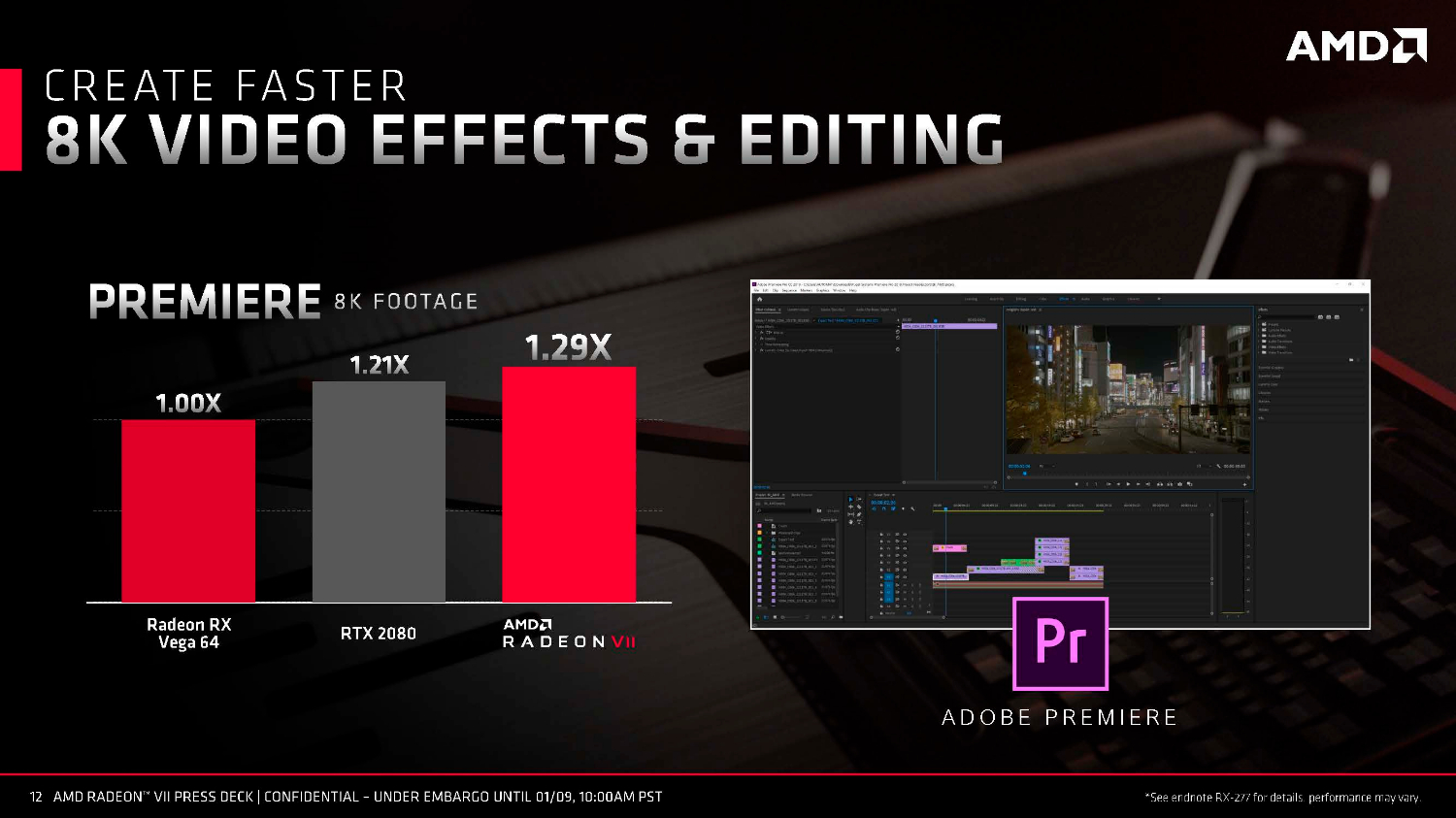
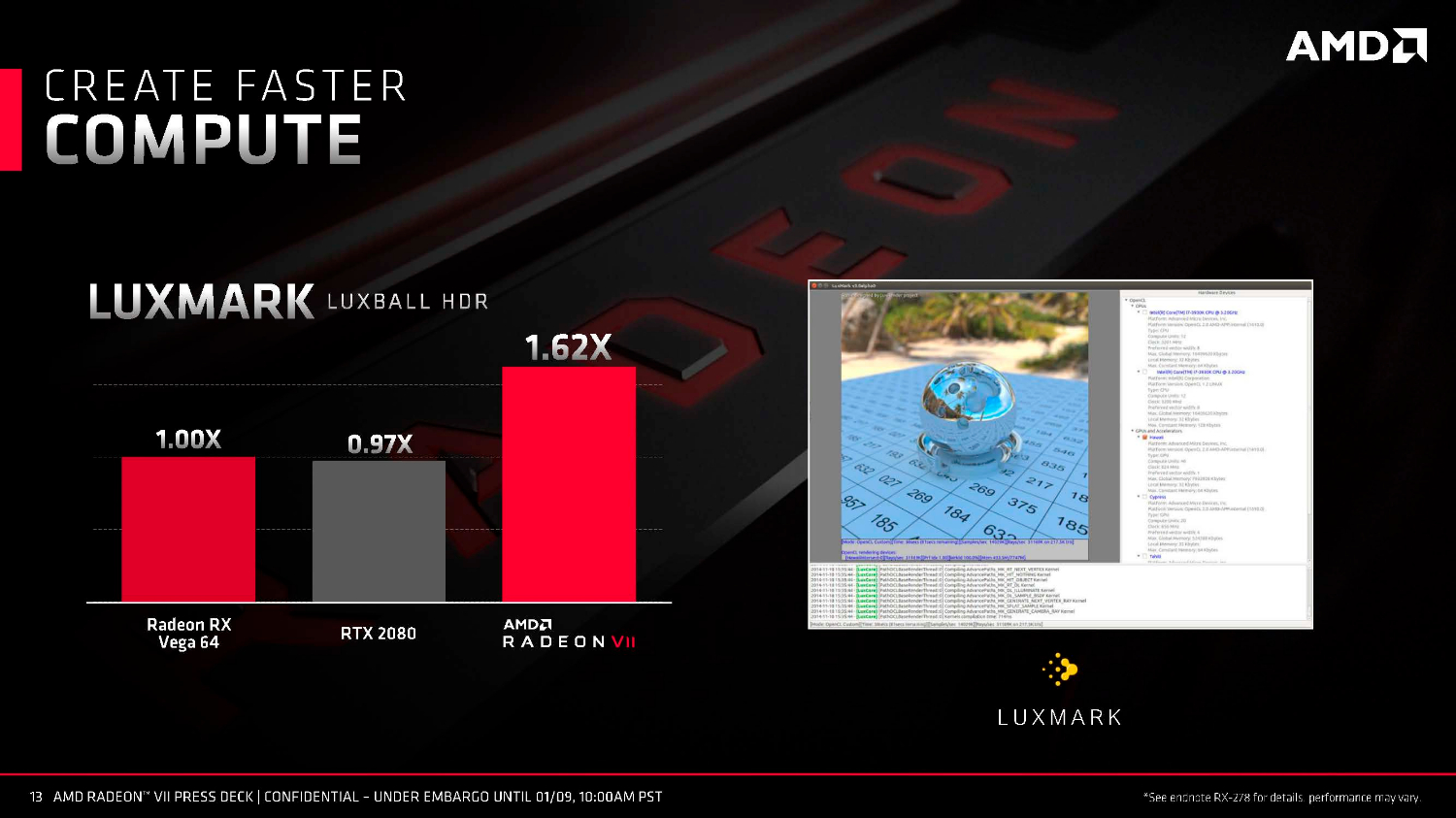

In the DaVinci Resolve 15 test, the Radeon VII is reportedly up to 27 percent faster than the Radeon RX Vega 64, and beats the GeForce RTX 2080 by 2 percent. While editing 8K footage in Adobe Premiere, the Radeon VII performs up to 29 percent and 8 percent faster than the Radeon RX Vega 64 and GeForce RTX 2080, respectively. However, the card only really begins to flex its muscles when it gets to LuxMark. The Radeon VII runs up to 62 percent faster than the Radeon RX Vega 64 and 65 percent faster than the GeForce RTX 2080. Lastly, the Radeon VII is 27 percent faster than the Radeon RX Vega 64 in Blender.

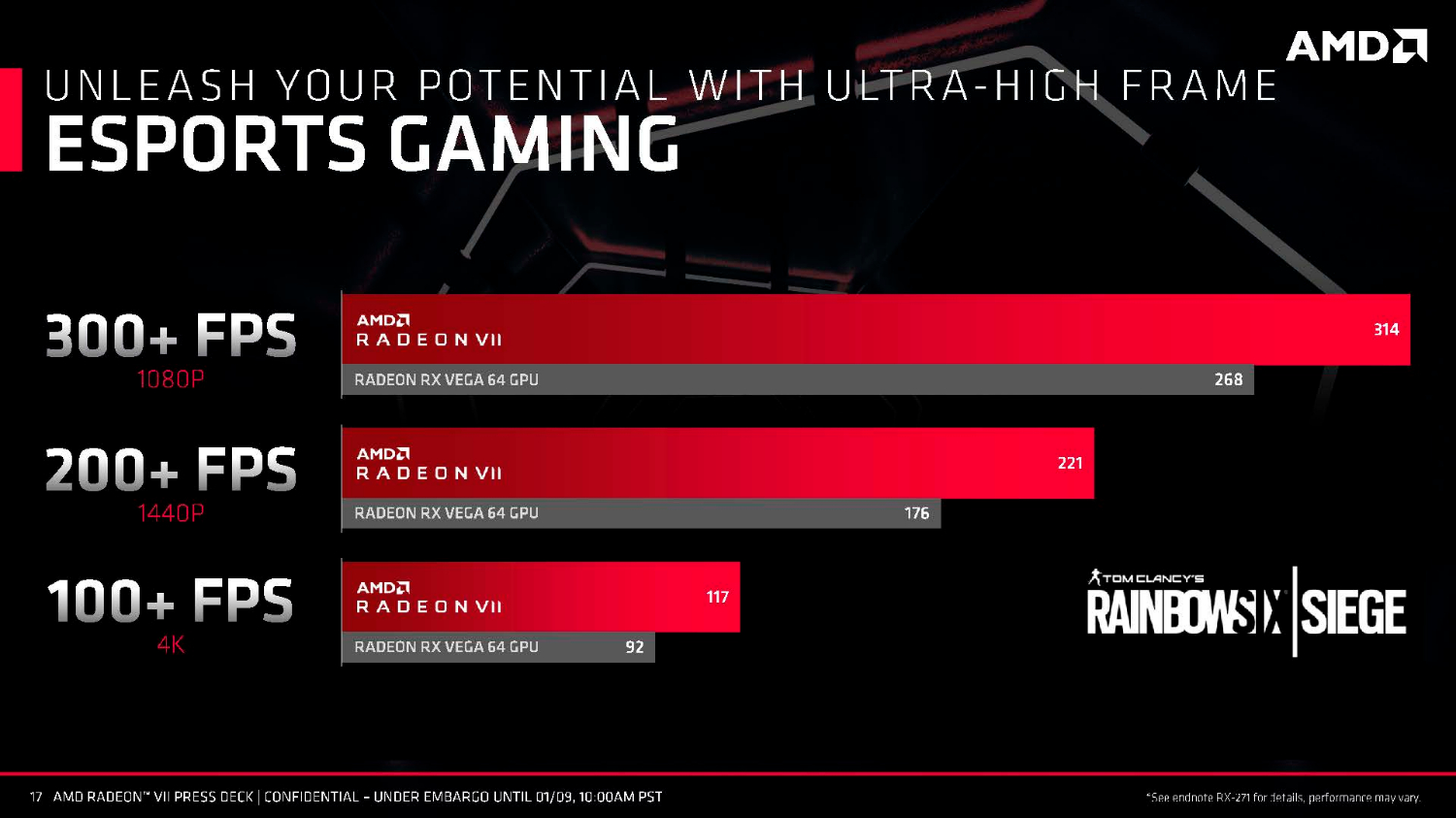

For the gaming tests, AMD benchmarked its new flagship at three different resolutions: 2560x1440, 3440x1440 super wide, and 3840x2160. The Radeon VII beats the RTX 2080 by 11.6 percent and the RX Vega 64 by 28.9 percent in Battlefield V at 2560 x 1440. In Forza Horizon 4 at 3440 x 1440, the Radeon VII is 14.8 percent faster than the Radeon RX Vega 64 but falls behind the GeForce RTX 2080 by 1 percent. When playing Strange Brigade at 3840 x 2160, it delivers up to 42.6 percent and 19.2 percent more performance than the RX Vega 64 and RTX 2080, respectively.
| Game | API | AMD Radeon VII | AMD Radeon RX Vega 64 | Difference |
| Assassin's Creed Odyssey | DirectX 11 | 36 FPS | 28 FPS | 28.6% |
| Battlefield 1 | DirectX 12 | 80.5 FPS | 59.2 FPS | 36% |
| Battlefield V | DirectX 11 | 68.1 FPS | 50.5 FPS | 34.9% |
| Battlefield V | DirectX 12 | 62.2 FPS | 46.7 FPS | 33.2% |
| Call of Duty: Black Ops 4 | DirectX 11 | 82.3 FPS | 68 FPS | 21% |
| Destiny 2 | DirectX 11 | 65.1 FPS | 50.9 FPS | 27.9% |
| Deus Ex: Mankind Divided | DirectX 12 | 53.4 FPS | 40.2 FPS | 32.8% |
| Doom (2016) | Vulkan | 89.5 FPS | 67.2 FPS | 33.2% |
| F1 2018 | DirectX 12 | 78 FPS | 61 FPS | 27.9% |
| Fallout 76 | DirectX 11 | 76.6 FPS | 45.5 FPS | 68.4% |
| Far Cry 5 | DirectX 11 | 62 FPS | 49 FPS | 26.5% |
| Fortnite | DirectX 11 | 46.9 FPS | 37.4 FPS | 25.4% |
| Forza Horizon 4 | DirectX 12 | 72.8 FPS | 62.8 FPS | 15.9% |
| Grand Theft Auto V | DirectX 11 | 76.2 FPS | 60.1 FPS | 26.8% |
| Hitman 2 | DirectX 11 | 53.3 FPS | 49.7 FPS | 7.5% |
| Just Cause 4 | DirectX 11 | 50.8 FPS | 42.6 FPS | 19.3% |
| Middle-Earth: Shadow Of War | DirectX 11 | 54.3 FPS | 41.6 FPS | 30.5% |
| Monster Hunter World | DirectX 11 | 35.4 FPS | 29.4 FPS | 20.4% |
| Rise of the Tomb Raider | DirectX 12 | 58.3 FPS | 46 FPS | 26.7% |
| Shadow of the Tomb Raider | DirectX 12 | 47.5 FPS | 36.3 FPS | 30.9% |
| Sid Meier's Civilization VI | DirectX 12 | 97.1 FPS | 78.1 FPS | 24.3% |
| Star Control: Origins | DirectX 11 | 88.9 FPS | 69.2 FPS | 28.5% |
| Strange Brigade | Vulkan | 86.7 FPS | 60.9 FPS | 42.4% |
| The Witcher 3 | DirectX 11 | 55.4 FPS | 41.4 FPS | 33.8% |
| Tom Clancy's Ghost Recon: Wildlands | DirectX 11 | 36.3 FPS | 29.2 FPS | 24.3% |
| Total War: Warhammer 2 | DirectX 11 | 34.6 FPS | 28.3 FPS | 22.3% |
| Wolfenstein II: The New Colossus | Vulkan | 93.4 FPS | 74.2 FPS | 25.9% |
| Overall | 28.5% |
AMD also compared the Radeon VII in a couple of eSports titles. The card delivered over 300 FPS at 1080p, 200 FPS at 1440p, and 100 FPS at 4K in Tom Clancy's Rainbow Six Siege. When it comes to Fornite, it's around 25 percent faster than the RX Vega 64. AMD puts a strong emphasis on streaming. The performance cost for gaming and streaming simultaneously, Fornite at 1080p, 60 FPS with Open Broadcaster Software (OBS) on a Radeon VII is just a mere 3 percent.
Availability and Pricing
Consumers can purchase the Radeon VII for $699 directly from AMD beginning on February 7. For a limited time, the graphics card will come with the 'Raise the Game Fully Loaded' bundle, which includes free copies of Resident Evil 2, Devil May Cry 5, and Tom Clancy's The Division 2.
Correction: An earlier verison of this article incorrectly reported the number of ROPs as 128; it is 64.

Zhiye Liu is a news editor, memory reviewer, and SSD tester at Tom’s Hardware. Although he loves everything that’s hardware, he has a soft spot for CPUs, GPUs, and RAM.
-
JamesSneed "The AMD Radeon VII comes equipped with 60 compute units, and since the graphics card adheres to the GCN standard, this tallies up to 3,840 stream processors, 240 TMUs (texture mapping units), and 64 ROPs (render output units)"Reply
I thought it had 128 ROP's? -
redgarl It might be a better product than we first though. If it can beat the 2080 RTX in a many titles, it could be a more interesting product than my initial take.Reply -
shrapnel_indie Reply21664771 said:295W???
That's quite a bit, certainly... most homebuilts won't have an issue with that if built properly.
Now, I realize that there was no Ray Tracing involved, and the titles/apps used were probably cherry picked.... but what I could gather with the data provided... it can outperform the RTX2080... It's nice to see that... but as pointed out... 295W is the cost outside of initial investment. I'm sure we'll know more once we get to see actual reviews. -
ThatTechieGuy That a ton of power for 7nm. Was hoping it would be 25% less than NVIDIA. Also had PCIE4 on the wishlistReply -
wwaaacs5 hm if it does 4k better without ray tracing, ill prob get it over the 2070 or 2080. i don't much care for the performance hit ray tracing causes, plus i do a lil editing on the side, seems that this will probably be better for me.Reply -
collin3000 Ray tracing doesn't matter yet.... But at only a $50 price Delta (if you catch a 2080 on sale) i'd honestly go Nvidia. I hope 3rd party Vega 2's are cheaper. Especially if the TDP is 295w on 7nm vs 250w on a 2080Reply -
JamesSneed Reply21665034 said:Ray tracing doesn't matter yet.... But at only a $50 price Delta (if you catch a 2080 on sale) i'd honestly go Nvidia. I hope 3rd party Vega 2's are cheaper. Especially if the TDP is 295w on 7nm vs 250w on a 2080
You are likely spot on however we probably should wait to see test results. Personally I'm waiting for Navi and Nvidia's 7nm refresh before my next GPU purchase, so I can decide between those two products.
